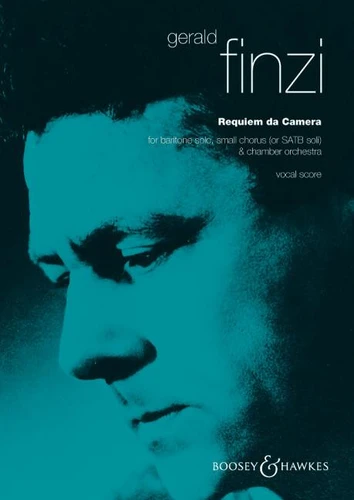Requiem da Camera. baritone solo, small chorus (or SATB soli) and chamber orchestra. Réduction pour piano.
Par :Formats :
- Paiement en ligne :
- Livraison à domicile ou en point Mondial Relay indisponible
- Retrait Click and Collect en magasin gratuit
- Réservation en ligne avec paiement en magasin :
- Indisponible pour réserver et payer en magasin
- Nombre de pages32
- Poids0.116 kg
- Dimensions18,5 cm × 26,0 cm × 0,0 cm
- ISBN978-0-85162-922-3
- EAN9780851629223
- Date de parution01/01/2014
- CollectionMUSIQUE D'ENSEM
- ÉditeurBOOSEY
Résumé
New edition with completion by Christian Alexander of the young composer's first extended work ; only the instrumental prelude was performed during Finzi's lifetime. The other three movements are settings of poems by John Masefield, Thomas Hardy and Wilfrid Wilson Gibson. Scored for baritone solo, small chorus (or SATB soli) and chamber orchestra, the wellspring of the Requiem's composition was the death, during active service in 1918, of Finzi's composition teacher, Ernest Farrar.
The work may also be viewed as a metaphor - the permanence of the land, and a centuries-old pattern of rural life following the rhythm of the turning seasons, contrasted with the violent havoc and destructive dislocation wrought by war. A reflective and poignant work particularly suitable for performances commemorating the tragedy of World War I. Instrumentation : baritone solo, small chorus (or SATB soli) and chamber orchestra
The work may also be viewed as a metaphor - the permanence of the land, and a centuries-old pattern of rural life following the rhythm of the turning seasons, contrasted with the violent havoc and destructive dislocation wrought by war. A reflective and poignant work particularly suitable for performances commemorating the tragedy of World War I. Instrumentation : baritone solo, small chorus (or SATB soli) and chamber orchestra
New edition with completion by Christian Alexander of the young composer's first extended work ; only the instrumental prelude was performed during Finzi's lifetime. The other three movements are settings of poems by John Masefield, Thomas Hardy and Wilfrid Wilson Gibson. Scored for baritone solo, small chorus (or SATB soli) and chamber orchestra, the wellspring of the Requiem's composition was the death, during active service in 1918, of Finzi's composition teacher, Ernest Farrar.
The work may also be viewed as a metaphor - the permanence of the land, and a centuries-old pattern of rural life following the rhythm of the turning seasons, contrasted with the violent havoc and destructive dislocation wrought by war. A reflective and poignant work particularly suitable for performances commemorating the tragedy of World War I. Instrumentation : baritone solo, small chorus (or SATB soli) and chamber orchestra
The work may also be viewed as a metaphor - the permanence of the land, and a centuries-old pattern of rural life following the rhythm of the turning seasons, contrasted with the violent havoc and destructive dislocation wrought by war. A reflective and poignant work particularly suitable for performances commemorating the tragedy of World War I. Instrumentation : baritone solo, small chorus (or SATB soli) and chamber orchestra














